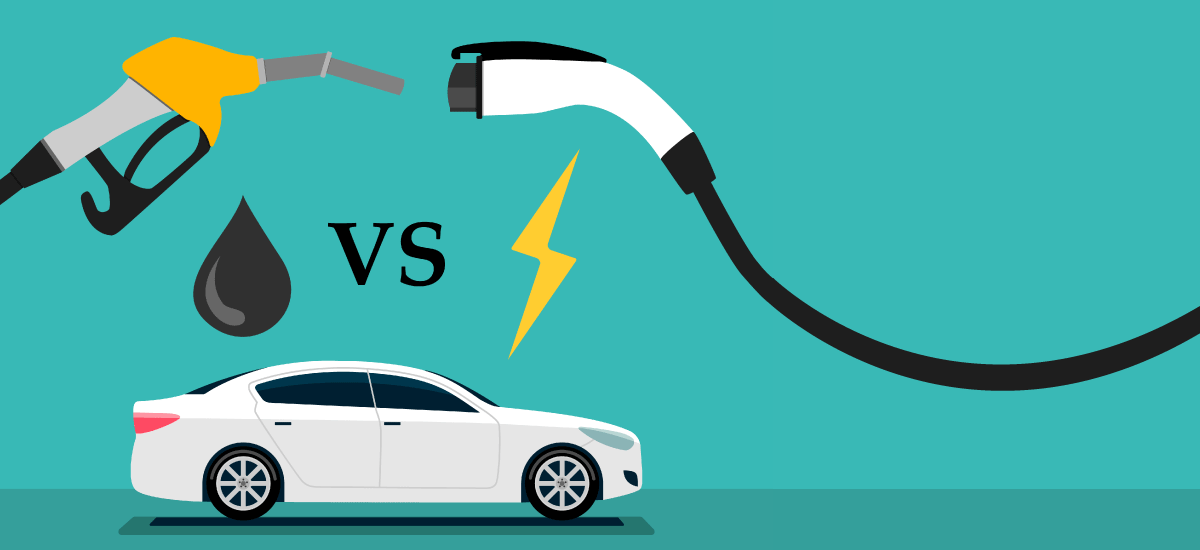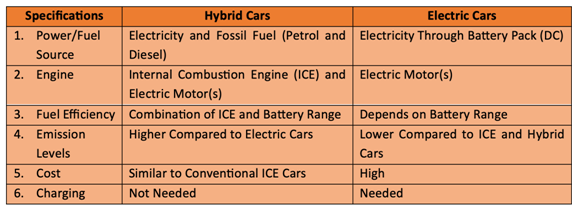What’s in Today’s Article?
- About Hybrid Vehicles (Meaning, Difference w.r.t. EVs, Importance of Hybrid Vehicles)
- Challenges w.r.t. EVs
What is a Hybrid Vehicle?
- Hybrid cars are powered by two engines: one petrol, one electric.
- Both work with each other to spin the wheels. This leads to lesser petrol being burned and therefore better fuel efficiency.
- When compared to conventional vehicles, hybrids offer better power and fuel efficiency as they combine the benefits of high fuel efficiency and low emissions.
- When hybrid vehicles are cruising or while braking, the result is excess power which is used to charge the batteries. This, in turn, aids higher fuel efficiency or range.
Difference Between Hybrid & Electric Vehicles:
Why Hybrid Vehicle is a Practical Solution for Decarbonisation Drive?
- According to a report by HSBC Global Research, India needs to embrace hybrid vehicles over the next 5-10 years on the way to full electrification.
- Such vehicles are the more practical medium-term solution for the country’s decarbonisation efforts and, more importantly, less polluting, according to the note.
- The note says that currently, overall carbon emissions are lower in hybrids compared to both electrics and those that run on petrol and diesel for similarly proportioned vehicles.
- In fact, it could take as long as a decade for EV and hybrid vehicle emissions to come to the same level, it says.
- Currently, India’s electric mobility plan is largely focussed on battery electric vehicles or BEVs replacing internal combustion engine (ICE) vehicles.
- Carbon Emission Comparison:
- The note said that total (well-to-wheel, or WTW) carbon emissions from an EV is currently 158 g/km, compared to 133 g/km for hybrids — which means that a hybrid is at least 16% less polluting than the corresponding EV.
- These numbers are 176 g/km and 201 g/km for corresponding petrol and diesel vehicles respectively.
- EV and hybrid emissions could converge after 7-10 years, according to estimates made by the HSBC analysis.
- According to the note, total emissions from hybrid cars and EVs will converge if non-fossil power generation in India moves up to 44%.
- By 2030, even if India’s share of non-fossil fuels is 40%, hybrids will still release 8% less emissions than EVs, which, however, will be half of the 16% of today, the note said.
What are the Challenges w.r.t. Overall Global Push for EVs?
- Cumulative EV industry sales, comprising the two- and three-wheeler, passenger vehicle and commercial vehicle sub-segments, for 2023 are ~13.8 lakh units, which constitutes 50% year-on-year growth (January-November 2022: ~9 lakh units).
- However, there are a few challenges on the way to rapid adoption of battery electrics at scale.
- Upfront Subsidy:
- The experience in markets from Norway to the US and China shows that the electric push works only if it is backed by state subsidies.
- An elaborate system of incentives is central to Norway’s EV policy, which has fostered the world’s most advanced EV market.
- So, the government waives the high taxes it imposes on sales of non-electrics; it lets electric cars run in bus lanes; toll roads are free for electric vehicles; and parking lots offer a free charge.
- The problem with this kind of overt subsidisation of EVs, especially in developing countries like India, is that much of the subsidy ends up in the hands of the middle or upper middle classes, who are typically the buyers of battery electric four-wheelers.
- Charging Stations:
- An analysis by the World Bank has found that investing in charging infrastructure is between four and seven times more effective in ensuring EV adoption compared with providing upfront purchase subsidies.
- Both Norway and China, while offering purchase subsidies, have seen faster adoption of EVs also as a result of sustained efforts at expanding the public charging infrastructure.
- China, the leader in the number of publicly available chargers, accounts for 85% of global fast chargers and 55% slow chargers.
- The situation in India is very different from these countries.
- While the number of EVs had crossed 1 million by mid-2022 and will likely grow to 45-50 million by 2030, only about 2,000 public charging stations are currently operational across the country.
- Electricity Source:
- In several countries that have pushed EVs, much of the electricity is generated from renewables — Norway, for example, has 99% hydroelectric power.
- In India, the grid is still fed largely by coal-fired thermal plants.
- Therefore, unless the generation mix changes significantly, India would be using fossil fuel generation to power EVs.
- Theoretically, this would mean reduced tailpipe emissions in the cities, but continuing pollution from the running of the thermal plant.
- Value Chain:
- As India struggles to make inroads into the global lithium value chain, there is discussion on the need to diversify the country’s dependency on Li-ion batteries in the EV mix.
- The demand for Li-ion batteries from India is projected to grow at a CAGR of more than 30% by volume up to 2030, which translates to more than 50,000 tonnes of lithium requirement for the country to manufacture EV batteries alone.
- However, more than 90% of the global Li production is concentrated in Chile, Argentina, and Bolivia, alongside Australia and China, and other key inputs such as cobalt and nickel are mined in the Congo and Indonesia.
- India would, therefore, be almost entirely dependent on imports from a small pool of countries to cater to its demand.
- While other options to Li-ion are being explored, viability remains a key factor.





